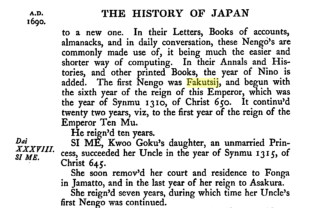Fakutsij
"Because our nation uses Chinese characters for its nengō [era names], their pronunciation is not always clear, and there are times when even dedicated scholars cannot pronounce them correctly." With this grim précis does Yamada Yoshio 山田孝雄 open his Nengō yomikata kōshō kō 年號讀方考證稿 ("Draft of an investigation into the pronunciation of era names"), a painstaking nengō-by-nengō compilation of pronunciations recorded in historical documents of varying authenticity.
Nengō yomikata an elegant book from a more civilized age. Its very raison d'être is thrown into doubt by the internet: why hire people to amass information on index cards and compile these into reference works for painstaking page-by-page consultation when we can search for what we want and find about 2,000,000 results in 0.12 seconds? (Answer: Because Google doesn't index this sort of information very well yet, and probably never will, since (a) OCRing premodern Japanese handwriting is a bear, wrapped in a tiger, inside a gorilla, and (b) Google can just index books like this instead. Details, details.)
Plus, as Yamada also makes clear in his introduction, the whole exercise of gathering nengō pronunciations is more akin to fieldwork in the natural sciences than puzzle-solving. In the vast majority of cases where doubt exists, there is no single "correct" answer — just trends, tendencies, and historical observations, which are more interesting anyway. Even the scholars charged with thinking up new nengō would observe that "sometimes they get read with the Han pronunciations, and sometimes with the Wu pronunciations," as if it wain't no thang. (The example Yamada quotes was incidental to an argument over whether Tennin 天仁 was a good name for an era, since it was pronounced the same as Tennin 天人, in which Ōe no Masafusa 大江匡房 deemed the association unproblematic in any case because heaven implied longevity; "Even in the lower heavens (下天), a day and a night is fifty human years long." This is the "What's wrong with being sexy?" of nengō debate.)
Anyway, Yamada's sources include some contemporary folk writing in Roman characters, especially Kaempfer and Rodrigues — which is good! Unfortunately for Kaempfer, his work stands out as a sort of proto-Grauniad among the other sources.

The first Nengo was Fakutsij, and begun with the sixth year of the reign of this Emperor [Kōtoku], which was the year of Synmu 1310, of Christ 650.
That's an unusual way to spell Hakuchi 白雉, but Kaempfer was from lands Germanic, and the <f> matches what he would have actually heard, so, okay.
A few paragraphs later, though:
It was not without great trouble and difficultv this Emperor [Temmu] got himself possess'd of the Throne, which was disputed him by his younger Brother Oto Mo No Oosi, who resolv'd to maintain his claim to the crown by force of arms, and at the head of a numerous army. But this unhappy Pretender was entirely defeated in five month's time, when out of despair he ript open his own belly. His body was honourably interr'd in the Temple Okamotto, situate in the Province Jamatto, in the ninth month of his Brother's reign. In memory of this Victory Ten Mu instituted the Nengo Fakwo, which continued fourteen years, till the beginning of the third Nengo Siuwu.
"Fakwo" is presumably Hakuhō 白鳳. Hakuhō is what you call an itsunengō 逸年号. This means that while it's not an "official" nengō recognized by imperial histories, the documents that reference it do place it within that tradition. (I.e., it wasn't declared as a propaganda effort by anti-imperial rebels.)
But what about "Siuwu"? The next nengō is supposed to be Shuchō 朱鳥, which has a completely different second half. Yamada suggests in a note that Kaempfer's reading may come from misreading that 鳥 ("bird", Sino-Japanese pronunciation chō) as 烏 ("crow", Sino-Japanese pronunciation u). Makes sense. (Meanwhile, poor old Rodrigues has "Xiujacu" 朱雀 in this position.)
Kaempfer keeps digging:
Soon after his accession to the Throne he [Emperor Monmu] begun a new Nengo, call'd Gen, which continu'd four years, and was follow'd by the Nengos, Tenpo of three years, and Keewuun of four years, but little us'd.
Okay, time out. I allowed "Fakutsij." I showed tolerance and understanding for "Siuwu." But "Gen" is definitely not a nengō. Kaempfer has apparently gotten confused by the word gannen 元年, meaning "the first year under a new nengō", and written with the character 元 which is more commonly pronounced gen Beyond that, the nengō after Suchō is supposed to be Taihō, not Tenpo. /h/ vs /p/ is a non-issue (indeed, it's exactly the kind of expected variation Yamada's book aims to address), but tai vs ten is way off. Yamada thinks it might come from misreading 大 as 天. Sigh.
Kaempfer: the original Japan blogger.
![[No-sword]](http://no-sword.jp/images/site/no-sword_banner.jpg)



language hat:
This is the sort of thing that makes me wish I hadn't dropped Japanese when I was four.